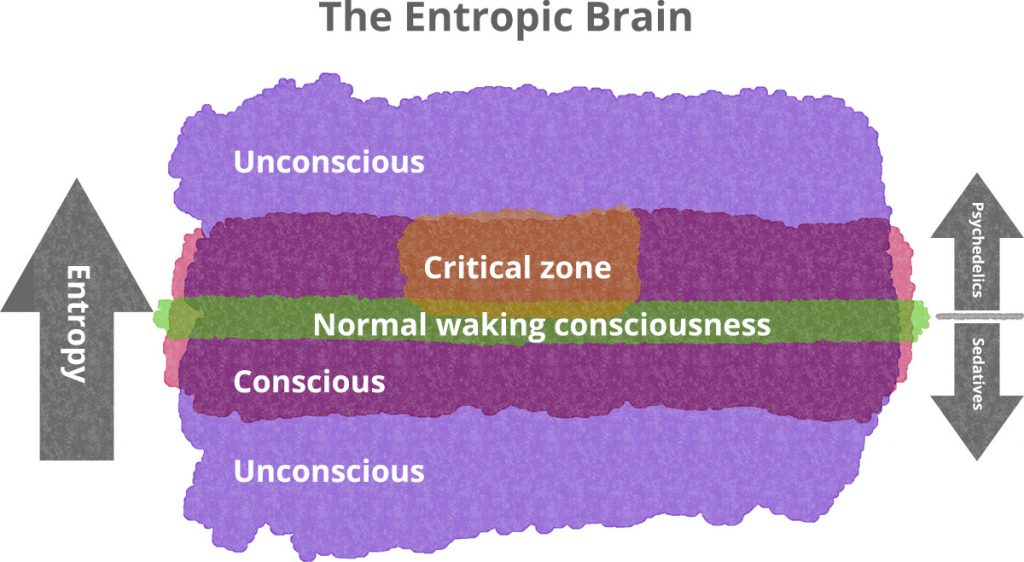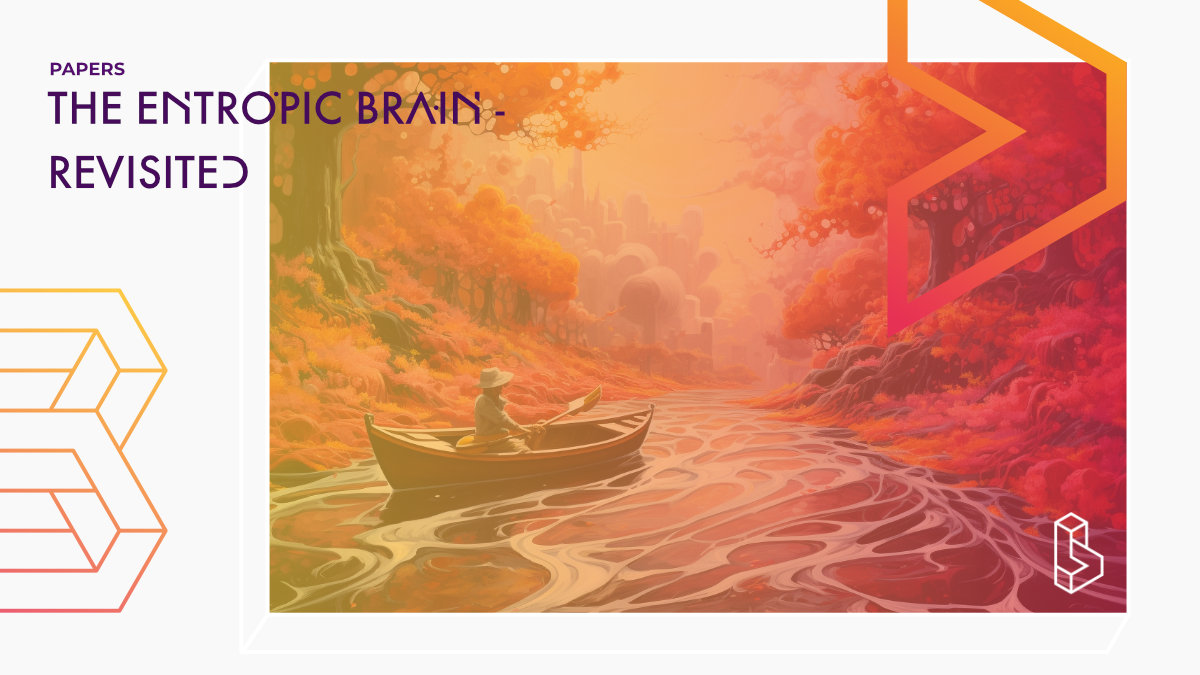This theory-building article (2017) offers more evidence for the entropic brain hypothesis, a hypothesis that under psychedelics the brain reaches higher criticality and is more susceptible to set and setting (bottom-up information). The study serves as a (possible) framework for why psychedelics work so well for a variety of mental disorders (in combination with psychotherapy).
Abstract of The entropic brain – revisited
“It is shown that the principle that the entropy of brain activity is elevated in the psychedelic state is increasingly well supported by separate and independent studies and analyses, and evidence for greater brain criticality under psychedelics is also highlighted. It is argued that heightened brain criticality enables the brain to be more sensitive to intrinsic and extrinsic perturbations which may translate as a heightened susceptibility to “set” and “setting”. This updated version of the original entropic brain hypothesis now offers more concrete information on specific measures of brain entropy and suggests new studies to scrutinise it further, as well as examine its utility for describing and informing the treatment of psychiatric and neurological conditions such as depression and disorders of consciousness.”
Author: Robin L. Carhart-Harris
Notes on The entropic brain – revisited
This revision of the entropic brain theory gives more body Carhart-Harris et al. (2014) – The entropic brain
Carhart-Harris & Friston (2019) – REBUS and the Anarchic Brain builds further on these ideas.
- Further evidence for the entropic brain hypothesis, more experiments, and measures
- Highlights the ‘brain criticality’ as part of the heightened entropy during the psychedelic states
- The entropic brain may be a good way of describing mental health disorders (and disorders of consciousness)
The goal of this paper is to give an update to the earlier paper (Carhart-Harris et al., 2014). The main points discussed are:
- “A more explicit statement that the qualia of time-averaged conscious states can be predicted by brain entropy,
- Reference to specific measures of entropy thought to meaningfully index the qualia of conscious states,
- A specific example of an important empirical, therapeutically relevant question that may be tackled by the hypothesis,
- A specific example of a clinical problem (namely disorders of consciousness) where the hypothesis may inspire a novel intervention,
- New data and thoughts on properties of brain criticality in the psychedelic state,
- How heightened brain criticality confers maximal sensitivity to perturbation via intrinsic or extrinsic sources (“set” and “setting),
- How there may be an upper bound to the entropic brain principle beyond which unconsciousness occurs,
- How recent findings on brain serotonin encoding behavioral responses to uncertainty mesh well with the entropic brain hypothesis.“
“… [tackled] the question of what increased entropy in the brain relates to in terms of conscious experience, proposing that richness of conscious experience, information content and subjective uncertainty are all close relatives – if not direct counterparts – of increased brain entropy (at least within a critical zone).”
Further Discussion/Analysis
“The first thing to note is that the theory has received significant empirical support since its introduction in 2014 … the magnitude of these increases in entropy correlated with the subjective intensity of the drug ‘trips’.”
Research with different classical psychedelics (but also ketamine) has corroborated the entropic brain hypothesis. This concerns both the perceived (long-term) effects as fMRI measures.
“Consciousness is proposed to arise within a critical zone at which the entropy or complexity of brain activity is neither too ordered nor disordered. Normal waking consciousness is proposed to inhabit a band within this zone, albeit towards its upper end. Psychedelic compounds are proposed to shift brain entropy and conscious content upwards, higher within the zone of criticality, towards greater conscious content, flexibility of mind and emotional lability but with a trade-off on the preservation of assumptions or beliefs and the sense of familiarity and assuredness they confer. Brain entropy (and criticality) may reach an upper limit at which consciousness is effectively lost – perhaps because phenomenal experience cannot be preserved beyond this point and thus, remembered. Sedatives and anaesthetics shift the brain downwards, i.e. into a subcritical zone and eventual unconsciousness, through loss of content and phenomenal experience.”
This is a good summary of the entropic brain hypothesis. Carhart-Harris also notes that it’s very unusual to even see a change in the level of entropy, he hopes that others who don’t study psychedelics (but do already study brains) might be tempted by these effects.
Below I’ve recreated a version of the image that describes the different parts involved.

It’s difficult to measure spontaneous brain activities. You can’t experimentally control it, and even trying to measure it may interfere with the level of brain activity. New functional neuroimaging techniques (sliding windows, point-process, intrinsic ignition) may help overcome some of these difficulties. But they probably won’t completely overcome the brain/objective or mind/subjective divide.
Psychedelics may help shed light on the unconscious (see image above), but maybe testing this should start with smaller steps. “One such component is that psychedelics facilitate ‘emotional insight’, i.e. definable as the acquisition of new thoughts, ideas or realisations about one’s self (or ‘persona’ – to use a Jungian term), assumptions and behaviour. Such insights may (or may not) then lead to subsequent changes in assumptions, perspectives and behaviour.” One study already found greater psychological insight with psilocybin vs an active placebo (dextromethorphan).
Carhart-Harris proposes different methods for measuring emotional insight. Experience sampling (asking participants about their experience at (pseudo-)random times) may be the best option. This way a direct measure of insight could be found, instead of that only being registered after the fact. Other ways might be to look at what the participants describe and study the word-use (how novel/creative), or how bizarre (weird) the description is that the participant gives.
“Can psychedelic-induced consciousness-enrichment be used to treat disorders of consciousness?”
Earlier research concluded that normal waking consciousness (green line in image) was the highest level of entropy for the brain. So the finding of higher entropy under psychedelics may offer hope for those with disorders of consciousness (coma, vegetative state, minimally conscious state). But research into this area has yet to start (proof-of-principle experiments).
Psychedelics increase the criticality in the brain (see The entropic brain). Some new research highlights that the set and setting (and integration afterward) can enhance the experience. For instance, when music matched the mood of participants, they had more ‘peak experiences’.
“A particularly exciting development is the discovery that unlike the dopamine system, serotonin appears not to encode classic reward/punishment information but rather value nonspecific ‘surprise’.”
This is in line with the entropic brain hypothesis (more entropy = more surprise). Serotonin thus may help with learning new behaviors and relax prior beliefs.
The paper ends with a discussion of the limitations and possible critique of the entropic brain hypothesis. It notes what things haven’t been considered and on what other theories (of the brain) this work was built.
Summary of The entropic brain – revisited
The entropic brain hypothesis proposes that the magnitude of entropy can index the subjective quality of a conscious state in a given parameter of spontaneous brain activity, and that greater entropy equals greater uncertainty and information-content.
The entropic brain hypothesis predicts the qualia of time-averaged conscious states by brain entropy and may inspire a novel intervention in disorders of consciousness.
Find this paper
The entropic brain - revisited
https://doi.org/10.1016/j.neuropharm.2018.03.010
Paywall | Google Scholar | Backup | 🕊
Authors
Authors associated with this publication with profiles on Blossom
Robin Carhart-HarrisDr. Robin Carhart-Harris is the Founding Director of the Neuroscape Psychedelics Division at UCSF. Previously he led the Psychedelic group at Imperial College London.
Linked Research Papers
Notable research papers that build on or are influenced by this paper
The entropic brain: a theory of conscious states informed by neuroimaging research with psychedelic drugsThis seminal paper (2014) introduces the entropic brain hypothesis intending to build a bridge between neuroscience and psychoanalytic theories. The entropic brain hypothesis proposes two different forms of cognition, one being more 'critical' and unconstrained (whilst under psychedelics). It has become one of the major theories underlying our understanding of how psychedelics exert their therapeutic effects.
REBUS and the Anarchic Brain: Toward a Unified Model of the Brain Action of Psychedelics
The REBUS and the anarchic brain hypothesis paper (2019) argues that psychedelics relax the precision of high-level priors or beliefs, thereby liberating bottom-up information flow, particularly via intrinsic sources such as the limbic system.

